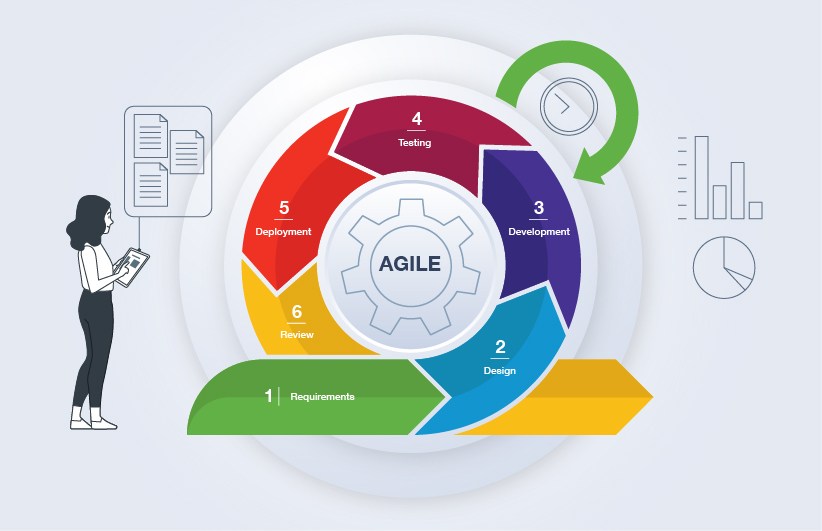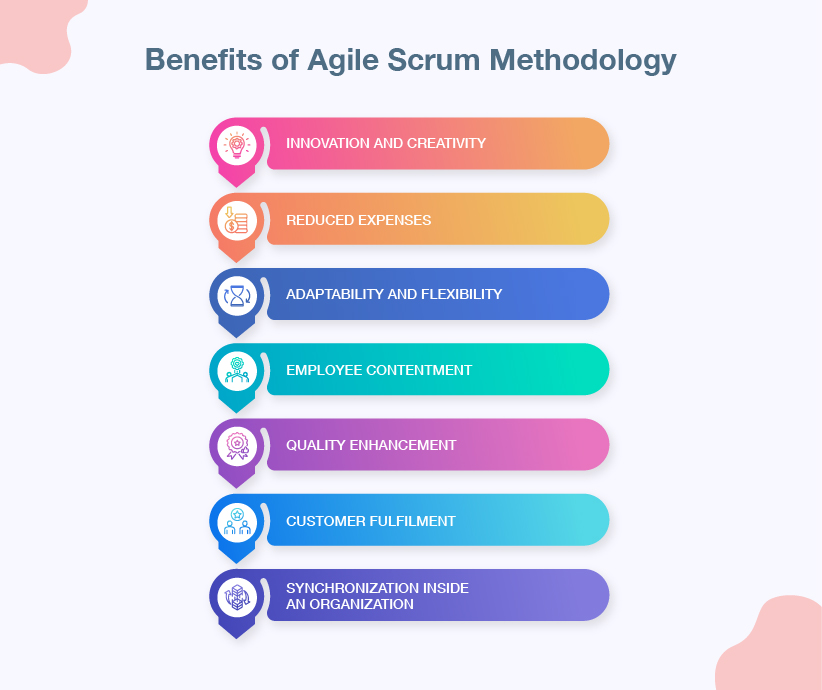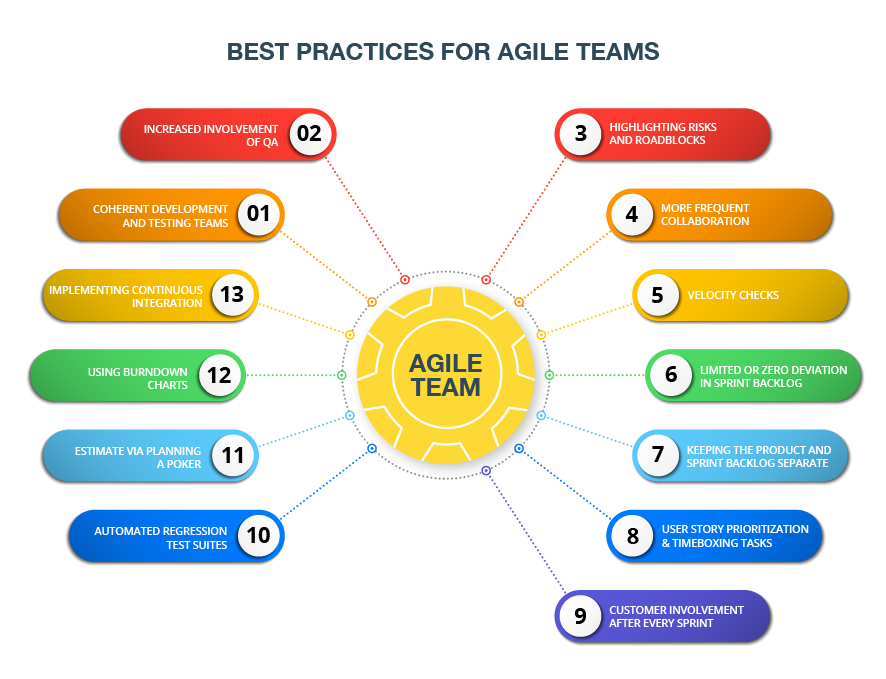Agile Scrum is a popular way for businesses of all sizes to create high-quality products quickly and efficiently. It’s an approach that focuses on working together, improving over time, and adjusting when things change. The Agile Scrum process is based on core principles and practices that help teams work better together and give customers what they want faster. This guide will show you the 13 best Agile practices to help you use the Agile Scrum methodology effectively in your organization. We’ll cover topics like how to plan with Agile, manage sprints, collaborate as a team, and deliver results continuously.
Are you new to Agile? Or maybe you’re already an expert? Either way, this guide will give you the tools and knowledge to get the most out of Agile Scrum. We’ll show you how to make your team more efficient, reduce project risks, and increase customer satisfaction. So if that sounds like something you need, this guide is for YOU!
Table Of Contents
- 1 What is Agile?
- 2 What is Scrum?
- 3 What is Agile Scrum Methodology?
- 4 How Does Agile Scrum Work?
- 5 What are the Benefits of Agile Scrum Methodology?
- 6 13 Best Agile Scrum Methodology
- 6.1 1. Coherent Development and Testing teams
- 6.2 2. Increased involvement of QA
- 6.3 3. Highlighting risks & roadblocks
- 6.4 4. More frequent collaboration in the team
- 6.5 5. Velocity Checks
- 6.6 6. Limited or zero deviation in Sprint Backlog
- 6.7 7. Keeping the product and sprint backlog separate
- 6.8 8. User Story Prioritization & Timeboxing Tasks
- 6.9 9. Customer Involvement after every sprint
- 6.10 10. Automated Regression Test Suites
- 6.11 11. Estimate via Planning a Poker
- 6.12 12. Using Burndown charts
- 6.13 13. Implementing Continuous Integration
- 7 Frequently Asked Questions
What is Agile?
Agile is a project management method that focuses on being flexible, working together, and improving. It’s about breaking down big projects into smaller parts and delivering them over short periods (sprints). Agile puts customers first by responding quickly to changes and immediately ensuring they get what they need. It also encourages everyone on the team to work together, share ideas, and help each other to reach the same goals.
Agile puts people and their interactions above processes and tools, working software over lots of paperwork, working with customers over negotiating contracts, and being ready to change instead of sticking to a plan. If you follow these values and principles, your team can be more efficient and productive and make customers happy. 97% of teams use Agile because it lets them frequently add new features to the product based on user feedback. This improves the product over time as changes are added in each iteration.
Agile software development is all about moving fast and efficiently. It’s the most popular way of making apps and websites. Scrum is the type of Agile that most people use. We’ll talk about some best practices for doing it right. Agile Scrum lets you customize the way you do things, but sometimes it’s easy to lose track of what makes it work so well in the first place.

What is Scrum?
Scrum is a framework of rules, roles, events, and artefacts for implementing Agile projects. It is a successful collaboration between teams working on complex projects. Scrum is a sort of agile technology that includes meetings, roles, and tools to assist teams working on complicated projects in collaborating and better structuring and managing their workload. According to the Scrum structure, each Sprint should begin with a brief planning meeting and end with a review meeting of the work completed during the Sprint.
What is Agile Scrum Methodology?
Agile scrum methodology is a project management technique that is based on iterative development. It entails ongoing engagement with stakeholders as well as continuous development at each stage. When the job begins, teams go through a cycle of planning, execution, and evaluation.
How Does Agile Scrum Work?
Agile scrum methodology is an iterative development-based project management process. The process is centred on iterative cycles known as Sprints, which typically span 2-4 weeks and during which the product is planned, coded, and tested while meeting on a daily basis to monitor progress (daily Scrum). As the task begins and teams go through the stages of planning, executing, and reviewing, it necessitates constant involvement with stakeholders.
After each sprint under the sprint-based paradigm, the scrum team often receives feedback from stakeholders. If difficulties or changes arise, the scrum team can easily and swiftly update product goals throughout subsequent sprints to produce more valuable iterations. Stakeholders are happier this way because they get exactly what they want after being involved at every step of the process.
What Are the Benefits of Agile Scrum Methodology?
- Innovation and creativity
- Reduced expenses.
- Adaptability and flexibility
- Employee contentment.
- Customer fulfilment.
- Synchronization inside an organisation.
- Quality enhancement.

13 Best Agile Scrum Methodology
Now, let’s review some of the best agile practices that, when implemented, will make sure that the company processes are optimized for best results.

1. Coherent Development and Testing Teams
In teams following Agile Scrum methodology, there should not be a demarcation line between DEV and QA teams. The developers, testers and the scrum master are supposed to be considered a part of one team performing their respective responsibilities to make the product a success.
Here, every sprint targets making a deliverable ready and the Development and QA work together to get it into a shape that can be reviewed by the customer while the scrum master makes sure that the team focuses on the most important tasks and gets them done on time.
2. Increased Involvement of QA
Since agile software development with scrum advocates working on the product in iterations in every cycle, testing also needs to be done in iterations. The target is to test the work done by developers in the same sprint. Thus, QA needs to be involved from the beginning of each sprint in all the user-stories understanding sessions and the sprint demos as well.
Making QA participate in the early stages ensures a reduced number of bugs in the later stages of development. Keeping QA involved since the start also means no big surprises for the end.
For a bird’s eye view on best automation test practices in Agile and continuous delivery, check the article here: Best Automation Testing Practices In Agile And Continuous Delivery
3. Highlighting Risks & Roadblocks
Agile methodology encourages teams to account for any distractions that may come up during an iteration in advance. During Scrum, at times, the team may skip elucidating the risks and roadblocks while planning for the sprint and get overwhelmed with the sprint backlog, high priority bugs or some urgent customer enhancement requests during the sprint.
Thus, to avoid any end moment surprises, the delivery team should try to estimate the efforts that may go into dealing with the risks and roadblocks and prepare plans for end deliverables accordingly.
4. More Frequent Collaboration in the Team
Agile software development with scrum recommends short meetings daily between the teams. These meetings help in re-evaluating the team’s progress every single day and adjusting the sprint goal accordingly.
In Scrum, there are standup meetings daily. These meetings help in managing the focus of the delivery team as any blockers can be flagged and handled the same day they are encountered. The team members are also able to gather information about each other’s progress and are encouraged to share their inhibitions if any. Following Scrum master best practices will help the team perform better.
5. Velocity Checks
The concept of Agile helps in knowing the capacity of the team in being able to deliver the user stories. It’s often calculated by measuring the number of user stories that have been achieved by the team during the initial 3-4 iterations.
This helps the project team forecast the number of user stories that the team is capable of delivering and helps in preparing further sprint backlogs efficiently based on the capability measured by velocity metric earlier.
6. Limited OR Zero Deviation in Sprint Backlog
One of the agile best practices is that there should be zero or limited changes in the sprint backlog to keep the team focused and ensure timely delivery unless some very urgent bug or feature needs to be accommodated.
In Scrum Methodology, a substantial amount of effort is put on planning this during sprint planning meetings to ensure that only the agreed-upon user stories/tasks are being taken up during the iteration.
7. Keeping the Product and Sprint Backlog Separate
The product backlog is the complete list of tasks that need to be done till the product is ready for final release while sprint backlog is the set of tasks that will be taken up in a certain sprint.
A recommended best practice for agile is to keep the product backlog and sprint backlog separate.
The idea is to separate the exhaustive list of product features and user stories from its subset that is to be implemented in any particular sprint. Doing this makes a clear demarcation between what the delivery team is expected to implement as a whole over multiple sprints and what the team is expected to deliver post a sprint.
8. User Story Prioritization & Timeboxing Tasks
One of the agile best practices that is always recommended is that the user stories and features should always be prioritized based on the business value being offered by them and the risks that are involved in implementing them. This approach enables the product owner and other stakeholders to estimate the financial value associated with each user story and the user story with the highest financial value can be realized earlier.
Timeboxing the tasks or the user stories helps in remaining aligned and accountable towards their completion which otherwise can run for an indefinite amount of time.
9. Customer Involvement after Every Sprint
One of the main motives of practicing agile is getting the product ready for the customer in iterations and getting feedback during all such iterations. Agile can only be successful when taking feedback from the client or the customer after every sprint is given the importance it deserves.
10. Automated Regression Test Suites
Multiple iterations on the same product based on customer’s feedback results in multiple changes being incorporated and that also means a lot of time spent executing the same sanity and regression suites multiple times. Agile encourages having these sanity and regression suites automated. Having these tests automated significantly reduces the time and effort that goes in repetitive testing due to frequent code commits. Read why you need to automate Regression Tests.
If you are looking for an easy and quick way to get a headstart with your test automation, while you have a team that is not extensively trained in coding then this article will help you: Scriptless Test Automation
11. Estimate Via Planning a Poker
Estimates play an important part in making agile methodology successful. In scrum methodology, there are dedicated sprint planning meetings at the start of every sprint to ensure that no overestimation or under-estimation of tasks happens and the team stays close to their goals throughout the sprint. Teams practicing agile do better estimates when the planning poker technique is used which also serves as a team-building activity.
During the planning and estimation meeting, corresponding to a task each estimator has to pull a card with numbers assigned like 0, 1, 3, 5, 8, 13, 20… representing the complexity of the task being discussed. The complexity of a task is directly proportional to the time that will be spent completing it.
All the cards are pulled simultaneously by all the team members. if the value that shows up on all the pulled cards is the same, it becomes an estimate. If not, the team members have a discussion wherein the highest and lowest number estimator has to give a reasoning for their selection. Again there is another round of cards selection and this goes on till all the estimators agree on a particular estimate.
12. Using Burndown Charts
Agile utilizes the burndown charts in every sprint to assess the amount of work remaining at any particular time. It’s a graph with days on x-axis and work remaining on Y-axis and a slant line from top-left to bottom-right is an ideal graph as the work remaining keeps decreasing with the days in a sprint. Most of the scrum management tools provide such a chart for tracking.
13. Implementing Continuous Integration
Agile Scrum methodology works well when there is continuous feedback for the development tasks. Continuous Integration is especially helpful in enabling continuous feedback. Not only building the software every time a commit is there, but continuous integration should also include testing the build every time such that any discrepancy or issue is caught at the earliest.
Thus, for an organization that opts to implement Agile Scrum methodology for their software development and wants to achieve quick and frequent releases to the market, the above best practices are followed.
Testing is also an important part of scrum software development methodology. According to the guidelines of scrum implementation, a user story should only be marked done if the test cases for it have been implemented. This process now has a name too – insprint test automation.
For the smooth implementation of insprint test automation, it is essential to choose the right tool. Before taking the plunge, it should be ensure that the tool meets the specific requirements of your project.
Testsigma is one such test automation tool that is built to help teams smoothly transition to in-sprint test automation. The simple and easy test creation interface and features like “affected resources” and “self-heal” save a lot of maintenance time. Above all, it is completely hosted on the cloud – starting from test case creation interface to execution on the test lab to the reporting of results. If you are looking for an automation tool, then see why Testsigma for agile.
No hefty tool setup or framework creation. Full-fledged test automation is just a moment away. Try Testsigma Today.
Frequently Asked Questions
What is the Difference between Agile and Scrum Methodology?
Scrum is one of numerous methodologies used to apply the Agile project management style, which is based on a core set of values or principles. Scrum is a specialised Agile approach for project management.
Is Scrum a Part of Agile?
Yes, Scrum is a subset of Agile that consists of meetings, roles, and tools to assist teams working on complicated projects in collaborating as well as better structuring and managing their workload. Although it is commonly used by software development teams, scrum may assist any team working toward a similar goal.
What is the Difference between Agile and Scrum Testing?
Agile testing is a type of testing that happens while something is being built. It means that feedback from users and other people involved in the project is used to improve the product. Scrum testing is similar, but it’s done explicitly within the Scrum framework. This means testing each part of your making as it’s being made so that a finished product can be released at the end of each “sprint” (a set amount of time).
In a nutshell, Agile testing is a way of testing that fits with the Agile way of doing things. Scrum testing is a set of specific tests you do when using the Scrum system. Agile and Scrum are all about working together, being flexible, and improving over time, but Scrum gives you more rules to follow when making software.









